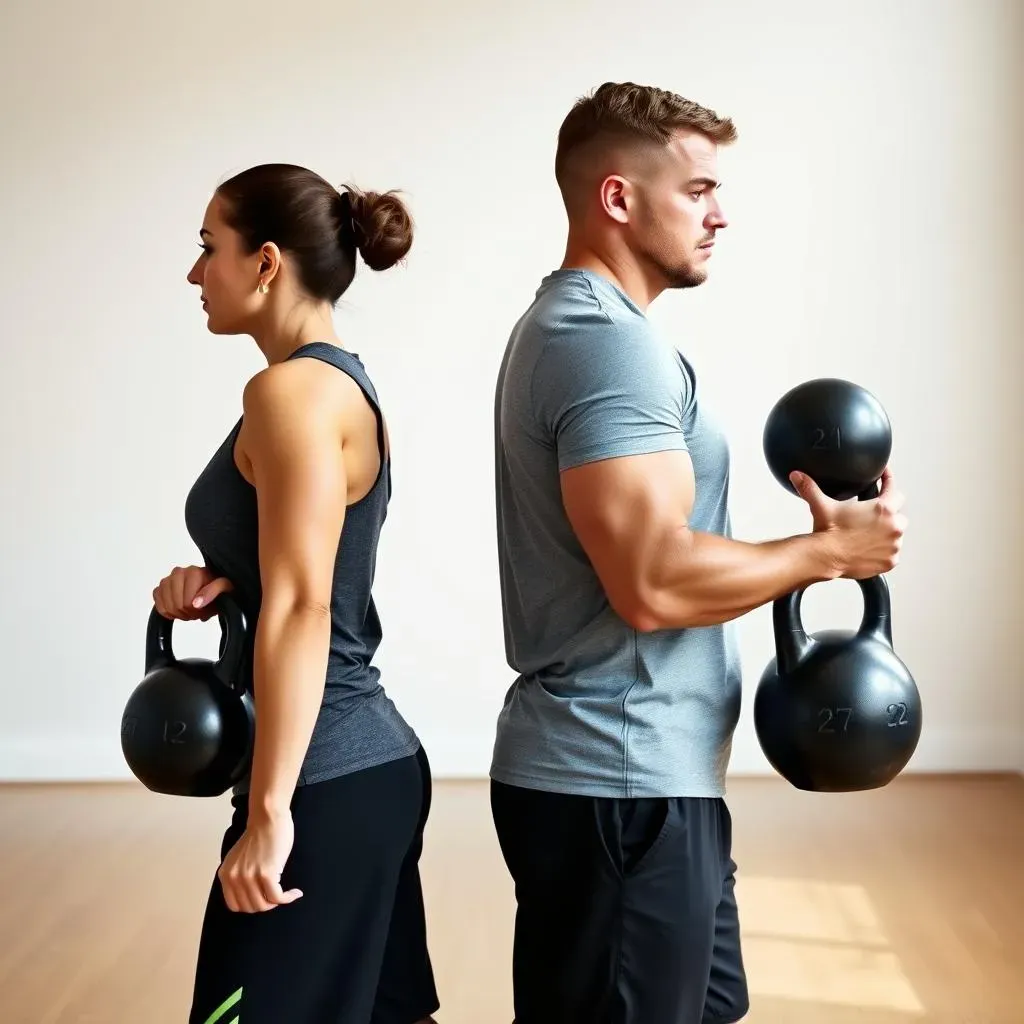Table of Contents
Tired of boring crunches? Want a core workout that's actually fun and effective? Then it's time to grab a kettlebell and get on your feet! We're not talking about those lying-down Russian twists that can sometimes tweak your back. This article will show you five dynamic standing kettlebell ab twist exercises that will sculpt your core, improve your balance, and get you feeling stronger than ever. Forget the floor, we're taking the kettlebell ab twist to a whole new level. We'll break down each move step-by-step, ensuring you've got the correct form. We'll also cover a simple workout format you can use right away. Get ready to feel the burn in your abs, obliques, and even those little stabilizer muscles you didn't know you had. Let’s get started and twist our way to a stronger core.
Why Standing Kettlebell Ab Exercises?

Why Standing Kettlebell Ab Exercises?
Alright, let's be real, floor ab work can get kinda boring, right? And sometimes, it's just not the most functional way to train your core. Think about it – how often do you crunch in real life? Probably never. Standing kettlebell exercises, on the other hand, mimic the way you move daily. They engage your core in a more natural and practical way. Plus, when you're standing, you're also working on your balance and stability, which are super important for everything from walking to playing sports. So, ditch the mat and let's get upright! We're not just targeting your abs; we're building a stronger, more resilient you from the ground up. It's about functional fitness, not just flexing in the mirror.
The 5 Best Kettlebell Ab Twist Exercises

The 5 Best Kettlebell Ab Twist Exercises
1. Standing Kettlebell Suitcase Marches
Okay, first up, we've got the Standing Kettlebell Suitcase Marches. This one might seem simple, but trust me, it's a killer for your obliques. Imagine you're carrying a heavy suitcase – that's the idea. Hold a kettlebell in one hand, let it hang by your side, and then march in place, lifting your knees high. The key here is to keep your core engaged and your body upright; avoid leaning to the side. You'll feel your abs working overtime to keep you stable as you lift each knee. It's not just about the march; it's about resisting the pull of the weight and keeping your spine straight. This is a great warm-up and a fantastic exercise for building a solid foundation. Start with a lighter weight and focus on control rather than speed.
The suitcase march isn't just about the core; it's a full-body move. As you lift each knee, you're also engaging your hip flexors and quads. This exercise helps to improve your posture and balance, making it a functional movement for everyday life. Think about carrying groceries or luggage; this move strengthens those exact muscles. The kettlebell acts as an external load, forcing your core to work harder to stabilize your body. Remember to breathe throughout the exercise, and keep the kettlebell from swinging too much. It's a controlled march, not a drunken sway. If it's too hard to march, start with standing and hold the bell on one side, and feel the obliques working.
2. Kettlebell Halos
Next up, let's make some halos! The Kettlebell Halo is a great way to work your entire core, but also your shoulders and upper back. Hold the kettlebell by the horns (the sides of the handle) in front of your chest. Now, slowly circle the kettlebell around your head, keeping it close to your head. Maintain a solid posture. The goal is to keep your core tight and your body still while the kettlebell makes a big circle around you. Don't let your back arch, or your hips sway. This isn't a race; it's about smooth, controlled movement. If you're new to halos, start with a lighter kettlebell to get the hang of the pattern. This exercise is excellent for improving shoulder mobility and core stability, and it's a fantastic way to warm up the spine.
The kettlebell halo is more than just a shoulder exercise; it's a full-body coordination challenge. As you move the weight around your head, your core muscles work hard to keep you stable. You’ll notice that your abs, obliques, and even the deep muscles of your back are engaged. The halo also forces you to focus on your breathing, which is crucial for maintaining stability. Don't rush it; focus on the movement pattern and the control. This exercise can improve your range of motion and help prevent injuries. If you feel any pinching or pain, stop and adjust your form or use a lighter weight. It's about listening to your body and working within your limits. As you get better, you’ll feel more stable, and you can increase the weight.
Exercise | Muscles Targeted | Benefits |
|---|---|---|
Standing Kettlebell Suitcase Marches | Obliques, Core, Hip Flexors | Core stability, balance, functional strength |
Kettlebell Halos | Core, Shoulders, Upper Back | Shoulder mobility, core stability, spinal warm-up |
How to Perform Kettlebell Ab Twist Correctly

How to Perform Kettlebell Ab Twist Correctly
Alright, let’s talk about nailing the form, because good technique is everything. When it comes to kettlebell ab twists, it's not about how much weight you can swing; it’s about how controlled and precise your movement is. First, always start with a weight you can handle comfortably. It’s better to go lighter and focus on form than to go heavy and risk injury. Proper stance is key; stand with your feet shoulder-width apart, knees slightly bent, and engage your core. As you twist, keep your chest up and your shoulders back. The movement should come from your torso, not your arms. Imagine you're wringing out a towel – that's the kind of rotation we're aiming for. Don’t let the kettlebell pull you; you're guiding it, not the other way around. It's a controlled twist, not a wild swing. If you feel any pain, stop immediately and adjust your form or lower the weight. Remember, it’s about quality over quantity.
Breathing is also a crucial part of proper form. Inhale before you start the twist, and exhale as you rotate, this will help to engage your core and maintain stability throughout the movement. Think of it as bracing your core with each exhale. Control is also very important. Don’t let the kettlebell momentum dictate the movement. You should be in control of the rotation, not the other way around. Focus on a smooth, controlled twist from side to side. Avoid jerky or sudden motions. If you’re feeling any strain in your lower back, it could be because you're twisting from your hips rather than your core. The movement needs to be coming from your midsection, not your lower back. If you're unsure, try practicing the movement in front of a mirror to check your form. Remember, consistency and proper technique are the keys to success and injury prevention.
Key Form Points | What to Avoid |
|---|---|
Engage your core | Twisting from hips |
Controlled movements | Jerky motions |
Maintain good posture | Arching your back |
Breathe with each twist | Holding your breath |
Kettlebell Ab Twist Workout Format

Kettlebell Ab Twist Workout Format
Okay, so you've got the moves down, now let’s talk about how to put it all together. This isn't about endless reps until you drop; it’s about smart, effective training. We're going to use a simple workout format called EMOM, which stands for "Every Minute on the Minute." This means that at the start of each minute, you'll perform a set number of reps of a specific exercise, and then you’ll rest for the remaining time in that minute. For this workout, we're going to do a 5-round circuit, which should take about 15 minutes or so. That’s it, short, sweet, and effective. You'll be working your core hard, but you'll also have some built-in rest, which is key for maintaining good form throughout the workout.
Here's the breakdown: for each round, you'll cycle through three exercises. First, you'll do 10 reps of the Standing Kettlebell Suitcase Marches (5 on each side). Then, you'll move to 8 reps of Kettlebell Halos (4 in each direction). Finally, you’ll finish with 10 reps of Kettlebell Windmills (5 on each side). Remember, the key is to maintain the correct form, so choose a weight that challenges you but doesn't compromise your technique. If you’re new to this, start with a lighter weight and focus on getting the movement right. As you get stronger, you can gradually increase the weight. Don't be afraid to modify as needed. If you need more rest, take it. This workout is about building strength and endurance, not about pushing yourself to the point of exhaustion. Listen to your body, and you’ll see great results.
Minute | Exercise | Reps |
|---|---|---|
1 | Standing Kettlebell Suitcase Marches | 10 (5 each side) |
2 | Kettlebell Halos | 8 (4 each direction) |
3 | Kettlebell Windmills | 10 (5 each side) |
After completing one round of those three exercises, you'll rest for a minute or two, and then you'll start the next round. Do a total of 5 rounds for a solid, effective workout. This format keeps things moving and ensures you're not spending too much time on any one exercise. As you work through the circuit, you'll notice that your core is constantly engaged, and you'll feel the burn in your abs, obliques, and back. Remember, this workout is scalable, meaning you can adjust the weight, the number of reps, or the rest time to suit your fitness level. If you find that the suitcase marches are too difficult, you can start with just holding the kettlebell on one side of your body. The most important thing is that you are moving and challenging yourself.
Remember that consistency is key. Aim to do this workout 2-3 times a week, and you’ll start seeing improvements in your core strength and stability. Don't be discouraged if you're not perfect at first. The journey of fitness is all about progress, not perfection. So, grab your kettlebell, set your timer, and let's get twisting. And if you want to add a little extra spice, try adding a few kettlebell swings to the end of each round. It's a great way to finish strong and get your heart rate up. The main thing is to have fun and enjoy the process of getting stronger. You've got this!
Wrapping Up Your Kettlebell Ab Twist Journey
So, there you have it, five awesome standing kettlebell ab twist exercises to add to your core routine. These aren't your grandma's crunches; they’re dynamic, engaging, and seriously effective. By incorporating these movements into your workouts, you'll not only build a stronger core, but you'll also improve your balance, coordination, and overall athleticism. Remember to start with a weight that's comfortable for you, focusing on proper form over how much you can lift. Consistency is key, so try to include these exercises a few times a week. With a little practice, you'll be twisting your way to a stronger, more sculpted core in no time. Now go grab that kettlebell and get twisting!